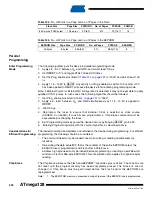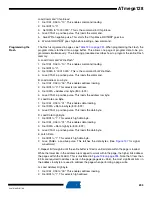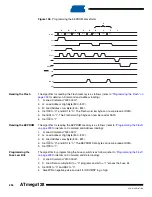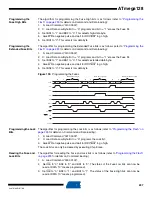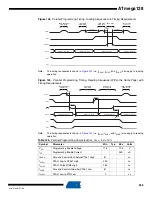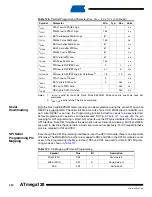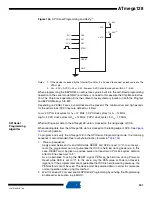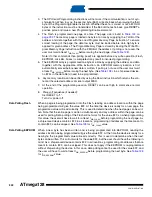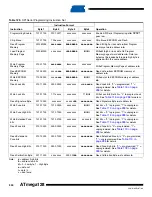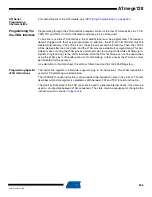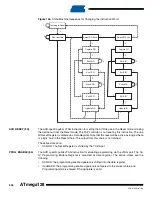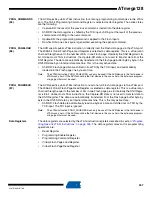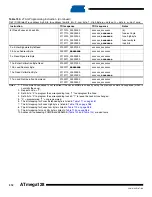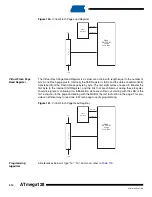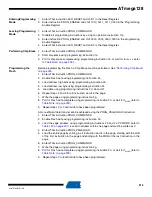
302
2467S–AVR–07/09
ATmega128
3.
The SPI Serial Programming instructions will not work if the communication is out of syn-
chronization. When in sync. the second byte ($53), will echo back when issuing the third
byte of the Programming Enable instruction. Whether the echo is correct or not, all FOUR
bytes of the instruction must be transmitted. If the $53 did not echo back, give RESET a
positive pulse and issue a new Programming Enable command.
4.
The Flash is programmed one page at a time. The page size is found in
. The memory page is loaded one byte at a time by supplying the 7 LSB of the
address and data together with the Load Program Memory Page instruction. To ensure
correct loading of the page, the data low byte must be loaded before data high byte is
applied for given address. The Program Memory Page is stored by loading the Write Pro-
gram Memory Page instruction with the 9 MSB of the address. If polling is not used, the
user must wait at least t
WD_FLASH
before issuing the next page. (See
).
Note: If other commands than polling (read) are applied before any write operation (Flash,
EEPROM, Lock bits, Fuses) is completed, may result in incorrect programming.
5.
The EEPROM array is programmed one byte at a time by supplying the address and data
together with the appropriate Write instruction. An EEPROM memory location is first
automatically erased before new data is written. If polling is not used, the user must wait
at least t
WD_EEPROM
before issuing the next byte. (See
). In a chip erased device,
no $FFs in the data file(s) need to be programmed.
6.
Any memory location can be verified by using the Read instruction which returns the con-
tent at the selected address at serial output MISO.
7.
At the end of the programming session, RESET can be set high to commence normal
operation.
8.
Power-off sequence (if needed):
Set RESET to “1”.
Turn V
CC
power off.
Data Polling Flash
When a page is being programmed into the Flash, reading an address location within the page
being programmed will give the value $FF. At the time the device is ready for a new page, the
programmed value will read correctly. This is used to determine when the next page can be writ-
ten. Note that the entire page is written simultaneously and any address within the page can be
used for polling. Data polling of the Flash will not work for the value $FF, so when programming
this value, the user will have to wait for at least t
WD_FLASH
before programming the next page. As
a chip-erased device contains $FF in all locations, programming of addresses that are meant to
contain $FF, can be skipped. See
for t
WD_FLASH
value
Data Polling EEPROM
When a new byte has been written and is being programmed into EEPROM, reading the
address location being programmed will give the value $FF. At the time the device is ready for a
new byte, the programmed value will read correctly. This is used to determine when the next
byte can be written. This will not work for the value $FF, but the user should have the following in
mind: As a chip-erased device contains $FF in all locations, programming of addresses that are
meant to contain $FF, can be skipped. This does not apply if the EEPROM is re-programmed
without chip-erasing the device. In this case, data polling cannot be used for the value $FF, and
the user will have to wait at least t
WD_EEPROM
before programming the next byte. See
for t
WD_EEPROM
value.





